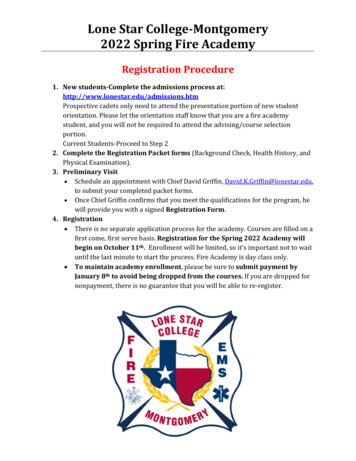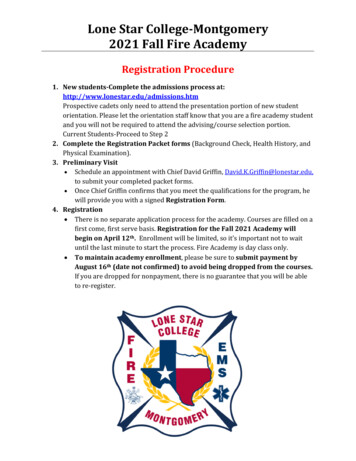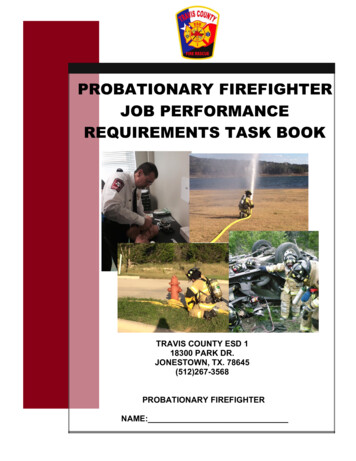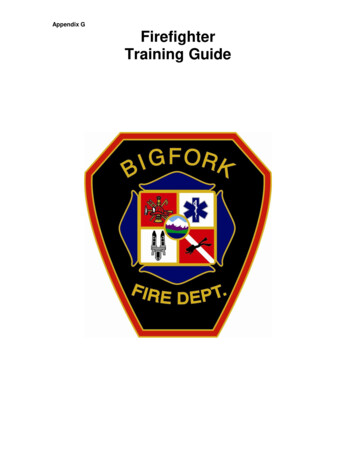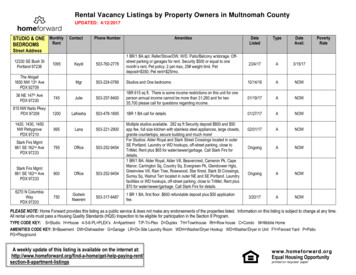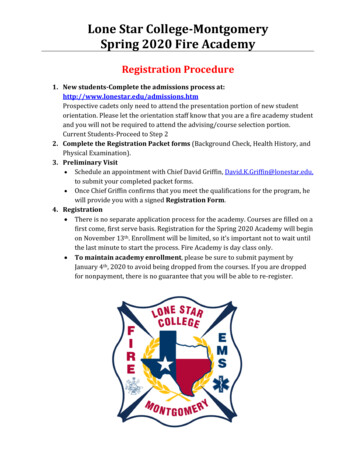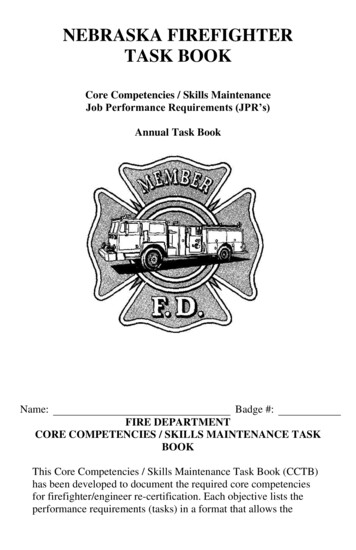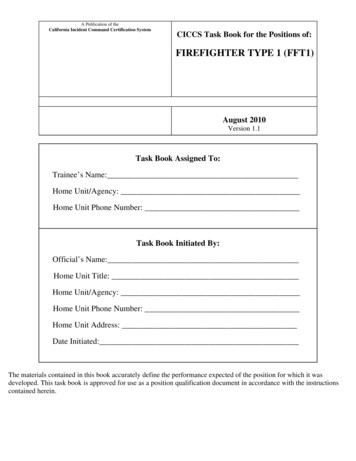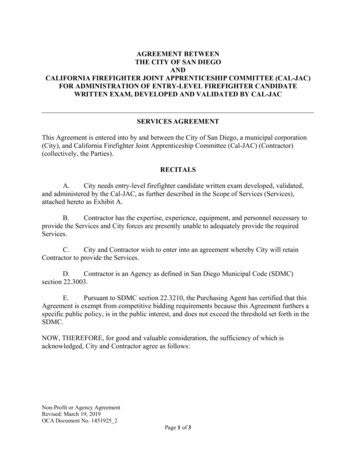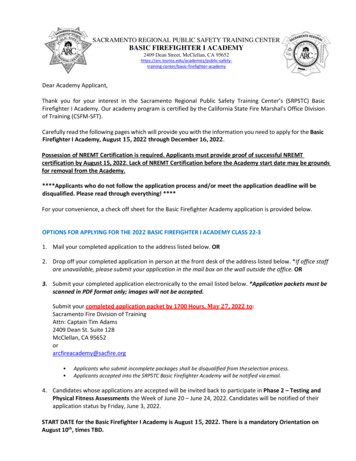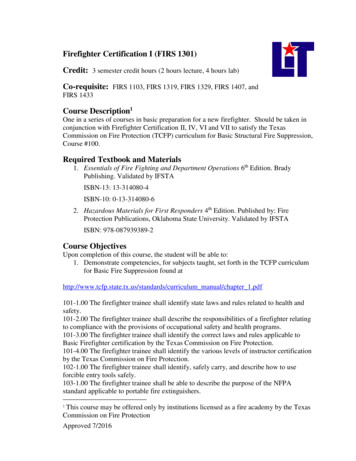
Transcription
Firefighter Certification I (FIRS 1301)Credit: 3 semester credit hours (2 hours lecture, 4 hours lab)Co-requisite: FIRS 1103, FIRS 1319, FIRS 1329, FIRS 1407, andFIRS 1433Course Description1One in a series of courses in basic preparation for a new firefighter. Should be taken inconjunction with Firefighter Certification II, IV, VI and VII to satisfy the TexasCommission on Fire Protection (TCFP) curriculum for Basic Structural Fire Suppression,Course #100.Required Textbook and Materials1. Essentials of Fire Fighting and Department Operations 6th Edition. BradyPublishing. Validated by IFSTAISBN-13: 13-314080-4ISBN-10: 0-13-314080-62. Hazardous Materials for First Responders 4th Edition. Published by: FireProtection Publications, Oklahoma State University. Validated by IFSTAISBN: 978-087939389-2Course ObjectivesUpon completion of this course, the student will be able to:1. Demonstrate competencies, for subjects taught, set forth in the TCFP curriculumfor Basic Fire Suppression found athttp://www.tcfp.state.tx.us/standards/curriculum manual/chapter 1.pdf101-1.00 The firefighter trainee shall identify state laws and rules related to health andsafety.101-2.00 The firefighter trainee shall describe the responsibilities of a firefighter relatingto compliance with the provisions of occupational safety and health programs.101-3.00 The firefighter trainee shall identify the correct laws and rules applicable toBasic Firefighter certification by the Texas Commission on Fire Protection.101-4.00 The firefighter trainee shall identify the various levels of instructor certificationby the Texas Commission on Fire Protection.102-1.00 The firefighter trainee shall identify, safely carry, and describe how to useforcible entry tools safely.103-1.00 The firefighter trainee shall be able to describe the purpose of the NFPAstandard applicable to portable fire extinguishers.This course may be offered only by institutions licensed as a fire academy by the TexasCommission on Fire ProtectionApproved 7/20161
FIRS 1301Course Syllabi104-1.00 The firefighter trainee shall be able to describe the purpose of the NFPAstandard applicable to ropes.105-1.00 The firefighter trainee shall be able to describe the purpose of the NFPAstandards applicable to fire service ladders.106-1.00 The firefighter trainee shall be able to describe the purpose of the NFPAstandards applicable to fire service hose.107-1.00 The firefighter trainee shall identify and describe the purpose of salvage and itsvalue to the fire department and in public relations.108-1.00 The firefighter trainee shall identify and describe the safety precautionsnecessary during overhaul.109-1.00 The firefighter trainee shall identify, define, and demonstrate characteristics offire streams.110-1.00 The firefighter trainee shall identify and describe the principles, advantages, andeffects of proper ventilation.111-1.00 The firefighter trainee shall describe and demonstrate the proper techniques ofsearching for victims.112-1.00 The firefighter trainee shall be able to describe the purpose of the NFPAstandard applicable to fire prevention inspections.113-1.00 The firefighter trainee shall describe the operation of fire hydrants, fully openand close fire hydrants, and identify the NFPA hydrant color code.114-1.00 The firefighter trainee shall be able to describe the purpose of the NFPAstandards applicable to fire protection systems.115-1.00 The firefighter trainee shall identify and describe the process of combustion anddefine key terms associated with fire science.116-1.00 The Firefighter trainee shall identify and be able to describe the purpose, goals,and definitions of the NFPA standards applicable to Hazardous Materials.117-1.00 The firefighter trainee shall explain, identify, or demonstrate emergency servicecommunication procedures.118-1.00 The firefighter trainee shall describe the importance and purpose ofcommunications between the fire department and the community.119-1.00 The firefighter trainee shall define the following terms related to wildland firesuppression.120-1.00 The firefighter trainee shall describe the purpose of the following NFPAstandards applicable to SCBAs.121-1.00 The firefighter trainee shall be able to describe the purpose of the followingNFPA standards applicable to personal protective equipment.122-1.00 The firefighter trainee shall be able to describe the purpose of the NFPAstandard applicable to professional firefighters.123-1.00 The firefighter trainee shall identify and describe the basic types of buildingconstruction and the general fire behavior expected with each type of construction.124-1.00 The firefighter trainee shall identify and describe the general requirements,purpose, and definitions of the NFPA standard(s) applicable to Live Fire TrainingEvolutions.125-1.00 The firefighter trainee shall identify the responsibilities of the firefighter whichcould assist in the subsequent investigation of a fire.2
FIRS 1301Course Syllabi156-1.00 The firefighter trainee shall demonstrate procedures for testing fire hose.158-1.00 The firefighter trainee shall list and describe dangerous building conditions.159-1.00 The firefighter trainee shall identify and define foam making appliances, andshall demonstrate a foam stream from each.160-1.00 The firefighter trainee shall recognize the characteristics of ventilating abasement.161-1.00 The firefighter trainee, operating as a member of a team, shall demonstrate theextrication of a victim from a vehicle.162-1.00 The firefighter trainee shall identify the types of fire extinguishers in anoccupancy and ensure that they conform to the fire prevention requirements for thatoccupancy.163-1.00 The firefighter trainee shall identify and describe water systems and theirfundamental components.164-1.00 The firefighter trainee shall identify the features and characteristics of automaticsprinkler systems.166-1.00 The firefighter trainee shall identify and be able to describe the purpose, goals,and definitions of the NFPA standards applicable to Hazardous Materials.173-1.00 The firefighter trainee shall identify and describe the basic types of buildingconstruction and the general fire behavior expected with each type of construction.174-1.00 The firefighter trainee shall extinguish or control live fires.175-1.00 The firefighter trainee shall identify the methods for protecting evidence for firecause determination.176-1.00 The firefighter trainee shall identify and describe the purpose of an incidentmanagement system.177-1.00 The firefighter trainee shall identify fire incident reporting systems.178-1.00 The firefighter trainee shall identify and describe the benefits and componentsof pre-incident planning.179-1.00 The firefighter trainee shall be able to describe various types of automotive fireapparatus, their functions, and their features.180-1.00 The firefighter trainee shall identify various types of fire apparatus pumps andpump components, and shall identify their function(s), theory(s), and principle(s) ofoperation.Course OutlineA. General1. Organization of the fire departmenta. Historyb. Organizational structure2. The role of the Fire Fighter I3. Mission of the fire servicea. Emergency activitiesb. Non-emergency activities4. The value of life safety initiatives in support of the fire department mission and toreduce fire fighter line-of-duty injuries and fatalitiesa. Courage To Be Safe So Everyone Goes Home3
FIRS 1301Course Syllabi5. Role of other agencies as they relate to the fire departmenta. Private entitiesb. Localc. Regionald. Statee. Federal6. Aspects of the fire department’s member assistance programa. Critical Incident Stress Management (CISM)b. Member Assistance Programs (MAP)7. Importance of physical fitness and a healthy lifestyle to the performance of dutiesof a fire fighter8. The critical aspects of NFPA 1500, Standard on Fire Department OccupationalSafety and Health Program9. The combustion process and key terms associated with fire sciencea. The four products of combustion commonly found in structural fires thatcreate a life hazardi. Flameii. Heatiii. Smokeiv. Gases and irritantsb. Key termsi. Fireii. Flash pointiii. Ignition temperatureiv. Fire pointv. Flammable or explosive rangevi. LELvii. UELviii.Boiling pointix. Oxidationx. Pyrolysisxi. Reducing agentxii. Vaporizationxiii.Combustionxiv.Vapor densityxv. Specific gravityxvi.Thermal layeringxvii.heat stratificationxviii.thermal balance10. Fire theorya. Key termsi. Fire triangleii. Fire tetrahedronb. The relationship of the concentration of oxygen to combustibility andfirefighter safety4
FIRS 1301Course Syllabii. Ventilation-limited fire conditionsii. Flow pathsiii. Door control11. Identify and describe heat energy sourcesa. Chemical heat energyb. Electrical heat energyc. Mechanical heat energyd. Nuclear heat energy12. The stages of a fire and describe the appropriate action to be taken forextinguishmenta. Conditions and associated hazards and the appropriate actions to be taken forextinguishmenti. Ignitionii. Growthiii. Decay - oxygen depletediv. Flashoverv. Fully developed/fully involvedvi. Decay - fuel depletedb. Special conditions that occur during a fire’s growthi. Flameover/rolloverii. Thermal layeringiii. Ventilation-limitediv. Backdraftc. Methods of heat transferi. Conductionii. Convectioniii. Radiationiv. Direct flame impingement13. Physical states of matter in which fuels are commonly founda. Three types of fueli. Solid fuelii. Liquid fueliii. Gaseous fuelb. Chemical and physical properties of fuelsi. Specific gravityii. Vapor densityiii. The theory of surface to mass ratio as it relates to the combustion process14. Chemical by-products of combustiona. Poisonous gases and irritants common in smokei. Carbon dioxideii. Carbon monoxideiii. Hydrogen cyanide15. Units of heat measurementa. British thermal unit (BTU)b. Fahrenheit (oF)5
FIRS 1301Course Syllabic. Celsius (oC)d. Calorie (C)16. Fire extinguishment theorya. fire extinguishment theoryb. four methods of extinguishmenti. Temperature reductionii. Fuel removaliii. Oxygen exclusioniv. Inhibiting chemical reaction17. Characteristics of water as it relates to its fire extinguishing potentiala. physical characteristics of waterb. Law of Specific Heatc. Law of Latent heatd. advantages and disadvantages of water as an extinguishing agente. Law of Heat FlowB. General Skill Requirements1. Types of personal protective equipment (PPE) ensemblesa. Station/work uniformsb. Structural firefightingc. Wildland firefightingd. Emergency medical service (EMS)e. Specialized ensembles (i.e. ARFF, technical rescue)2. Donning3. Doffing/preparing for re-use4. Care and maintenancea. Basic inspectionb. Advanced inspectionc. Record keepingd. Familiarization with NFPA 1851C. Fire Department CommunicationsD. Response to a reported emergency1. Procedures for reporting an emergencya. Conventional phoneb. Cellular phonec. Call boxd. Telecommunication Devices for the Deaf (TDD)e. Still alarms or walk-insf. Automatic alarms2. Departmental SOPs for taking and receiving alarmsa. Nature of emergencyb. Location of emergencyc. Caller informationd. Responding unitse. Call back number3. Radio codes or procedures6
FIRS 1301Course SyllabiE.F.G.H.I.a. Clear speech – plain Englishb. Emergency communicationsi. Emergency communications per AHJii. Maydayiii. Evacuation order4. Information needs of dispatch centera. Nature of emergencyb. Location of emergencyc. Caller informationd. Responding unitse. Call back numberReceive a telephone call1. Departmental standard operating procedures (SOPs)2. Phone etiquetteTransmit and receive messages via the fire department radio1. Departmental radio procedures and etiquette for routine traffic2. Departmental radio procedures and etiquette for emergency traffic3. Departmental radio procedures and etiquette for emergency evacuationproceduresActivate an emergency call for assistance, given vision-obscured conditions, PPE,and department SOPs, so that the fire fighter can be located and rescued.1. Personnel accountability systemsa. Passportb. Tag systemc. Electronic system2. Emergency communication proceduresa. Radiob. Face-to-facec. Taglined. Evacuation signal3. Emergency evacuation methodsa. Roof escapeb. Balcony escapec. Self-rescued. Ladder escapee. Room escapeFireground OperationsSelf-contained breathing apparatus (SCBA) during emergency operations1. Conditions that require respiratory protectiona. Oxygen deficiencyb. Elevated temperaturesc. Toxic environmentsd. Smoke (by-products of combustion)2. Uses and limitations of SCBAa. Wearer7
FIRS 1301Course Syllabi3.4.5.6.7.8.9.i. Facial and long hairii. Protective clothingiii. Donning(a) Properly donned(b) SCBA correctly worniv. Eyeglasses or contact lensesv. Use in high or low temperaturesvi. Accidental submersionvii. Communicationviii.Working in teamsix. Personal alert safety system (PASS)x. Doffingxi. Physical conditioningb. Equipmentc. Air supplyTypes of SCBAa. Open circuitb. Closed circuitc. Supplied air respirators (SARs)Components of SCBAa. Backpack and harness assemblyb. Air cylinder assemblyc. Regulator assemblyd. Face piece assemblye. PASS devicef. Rapid Intervention Crew/Universal Air Connection (RIC/UAC)Donning and doffing proceduresa. Over-the-head methodb. Coat methodc. Seat mountedd. Compartment mountedBreathing techniquesa. Controlled breathingb. Buddy breathingIndications for and emergency procedures used with SCBAa. Use of emergency by-pass or purge valveb. Rapid Intervention Crew/Universal Air Connection (RIC/UAC)c. Conservation of airPhysical requirements of the SCBA wearera. Cardiovascular conditioningb. Respiratory conditioningc. Psychological/emotional stabilityMaintenance and inspectionsa. Replacing a cylinderb. Refilling a cylinder8
FIRS 1301Course Syllabic. Cleaningd. Inspectionsi. Dailyii. Monthlyiii. AnnuallyJ. Respond on apparatus to an emergency scene1. Mounting procedures for riding fire apparatusa. Hand gripb. Footingc. Seatbelt2. Dismounting procedures for riding fire apparatus3. Hazards associated with riding fire apparatus4. Ways to avoid hazards associated with riding fire apparatusa. Seated and utilizing safety restraintsb. Hearing protection, if requiredc. Secure loose objects in cab5. Prohibited practicesa. Donning PPE while in motionb. Riding on the tailboard/sideboards6. Types of departmental personal protective equipment (PPE) and the means forusagea. Safety bars/gatesb. Safety chainsK. Establish and operate in work areas at emergency scenes1. Potential hazards involved in operating on emergency scenesa. Vehicle trafficb. Utilitiesc. Environmental conditions2. Proper procedures for dismounting apparatus in traffic3. Procedures for safe operation at emergency scenes4. Protective equipment available for members’ safety on emergency scenes5. Protective equipment available for members’ safety on work zone designationsL. Force entry into a structure1. Basic construction types within the department’s community or service areaa. Doorsi. Swinging doors(a) Inward opening(b) Outward opening(c) Double swingii. Wooden doorsiii. Metal doorsiv. Tempered plate glass doorsv. Revolving doorsvi. Sliding doors9
FIRS 1301Course Syllabivii. Overhead doorsviii.Fire doorsb. Windowsi. Checkrail windows (double-hung)ii. Casement windows (hinged)iii. Projected windows (factory)iv. Awning and jalousie windowsv. Plastic windows (high security)vi. Screened or barred windowsc. Wallsi. Masonry and veneered wallsii. Metal wallsiii. Wood frame wallsiv. Partition walls2. Operationa. Doorsb. Windowsc. Locks3. Dangers associated with forcing entrya. Through doorsb. Through windowsc. Through walls4. Toolsa. Cutting toolsb. Prying toolsc. Pushing/pulling toolsd. Striking tools5. Maintenance of toolsa. Axe heads and cutting edgesb. Wooden handlesc. Fiberglass handlesd. Unprotected metal surfacese. Power equipmentM. Exit a hazardous area as a team1. Personnel accountability systemsa. Passportb. Tag systemc. Electronic system2. Communication proceduresa. Radiob. Face-to-facec. Taglined. Evacuation signal3. Emergency evacuation methods10
FIRS 1301Course Syllabia. Roof escapeb. Balcony escapec. Self-rescued. Ladder escapee. Room escape4. What constitutes a safe haven/refugea. Absence of immediately dangerous to life and health (IDLH) hazardb. Area outside of collapse zone5. Elements that indicate or create a hazard6. Emergency procedures for loss of air supplya. Stay calm/don’t panicb. Activate PASS devicec. Declare MaydayN. Set up ground ladders1. Parts of a laddera. Beamb. Bed sectionc. Buttd. Butt spure. Fly sectionf. Guidesg. Halyardh. Heat sensor labeli. Hooksj. Pawls (dogs)k. Protection platesl. Pulleym. Railn. Rungo. Staypolep. Stopsq. Tie rodr. Tip2. Hazards associated with setting up laddersa. Overhead obstruction (energized power lines)b. Lifting and movingc. Uneven terraind. Soft spotse. High traffic areas (doorways)f. Exposure to flame or heat3. What constitutes a stable foundation for ladder placementa. Flat, stable surfaceb. Non-skid surface4. Different angles for various tasks11
FIRS 1301Course Syllabia. Roofb. Windowi. Entryii. Ventilation or workingiii. Rescue set5. Safety limits to the degree of angulation6. What constitutes a reliable structural component for top placementO. Attack a passenger vehicle fire operating as a member of a team1. Principles of fire streams as they relate to vehicle firesa. Straight streamb. Full fogc. Power cone2. Precautions to be followed when advancing hose lines toward a vehiclea. Uphillb. Upwindc. 45 degree angle approach3. Observable results that a fire stream has been properly applied4. Identifying alternative fuels and the hazards associated with thema. Compressed Natural Gas (CNG)b. Liquefied Petroleum Gas (LPG)c. Ethanold. High voltage electrical power5. Dangerous conditions created during a vehicle firea. Energy absorbing bumpersb. Hydraulic pistons (supports)i. Hatchbacksii. Trunksiii. Tailgatesiv. Hoodsc. Shock absorbers/strutsd. Toxic by-products of combustione. Supplemental Restraint System (SRS)f. Side Impact Protection System (SIPS)g. Batteriesh. Combustible metals6. Common types of accidents or injuries related to fighting vehicle fires and how toavoid thema. Traffic hazardsb. Injuriesc. Respiratory7. Access compartmentsa. Passengerb. Trunkc. Engine8. Methods for overhauling a vehicle12
FIRS 1301Course Syllabia. Chock wheelsb. Disable batteryc. Apply water thoroughlyd. Confirm no leaking fluids or fuelsP. Extinguish fires in exterior Class A materials1. Types of attack lines and water streams appropriate for attacking stacked, piledmaterials and outdoor firesa. Types of attack linesi. ¾ or 1 inch (booster or reel line)ii. 1½ to 1¾ inchesiii. 2 to 2½ inchesiv. 3 inch or greaterb. Water streamsi. Low volume (less than 40 GPM)ii. Handline (40 to 350 GPM)iii. Master (350 GPM or greater)2. Dangers associated with stacked and piled materialsa. Collapseb. Energized sourcesc. Products of combustiond. Increased weight (absorption of water)e. Exposures3. Various extinguishing agents and their effects on different material configurationsa. Wateri. Coolingii. Increased surface tensionb. Foami. Blanketing or smotheringii. Coolingiii. Decreased surface tension4. Tools and methods to use in breaking up various types of materialsa. Toolsi. Pike poleii. Rubbish hookiii. Rakeb. Heavy equipmenti. Tractorii. Dozer5. Difficulties related to complete extinguishment of stacked and piled materialsa. Agent penetrationb. Accessc. Density of materiald. Height and area of pile6. Water application methods for exposure protection and fire extinguishmenta. Direct application13
FIRS 1301Course Syllabib. Indirect application7. Dangers such as exposure to toxic or hazardous materials associated with storagebuilding and container fires8. Obvious signs of origin and causea. Burn patternb. Charringc. Evidence of accelerantsd. Trailers9. Techniques for the preservation of fire cause evidencea. Protect evidenceb. Preserve areac. Limit accessQ. Conduct a search and rescue in a structure1. Use of forcible entry tools during rescue operationsa. Strikingb. Pryingc. Cuttingd. Pulling2. Ladder operations for rescuea. Conscious victimb. Unconscious victimc. Fire fighter rescue3. Psychological effects of operating in obscured conditions and ways to managethem4. Methods to determine if an area is tenablea. Level of heatb. Smokec. Ventilation-limited fire conditionsd. Creation of flow pathse. Structural stabilityf. Risk/benefit analysis5. Primary and secondary search techniquesa. Define the followingi. Primary searchii. Secondary searchb. Search techniquesi. Right hand/left handii. Large area/small area considerationsiii. Rope assisted, or hose lineiv. Tools (used to extend reach during search)v. Vent-Enter-Isolate-Search (VEIS)6. Team members’ roles and goalsa. Finding victimsb. Obtaining information on the extent of the firec. Search priorities14
FIRS 1301Course Syllabii. Closest to fire areaii. Remainder of fire flooriii. Floor aboveiv. Floor belowd. Rescue vs. recovery7. Methods to use and indicators of finding victimsa. Probable victim locationsi. Behind doorsii. Under windowsiii. On/under bedsiv. In closetsv. In bathtubsb. Additional considerationsi. Type of occupancyii. Time of dayiii. Building size and arrangementiv. Information from neighborsv. Occupant indicators(a) Vehicles in driveway(b) Toys in yardc. Call out/listend. Victim sighting through opening (i.e. window/door)e. Door control to prevent flow paths8. Victim removal methodsa. Types of carriesi. Extremity carryii. Seat carryiii. Chair carryiv. Webbing dragv. Blanket dragvi. Ladder rescue(a) Conscious(b) Unconsciousb. Securing of a victimi. Basketii. Stretcheriii. Long spine boardiv. Other devices9. Considerations related to respiratory protectiona. Personal use/work timeb. Emergency proceduresc. Rescue air/RIT pakd. Conditions for usei. Heatii. Smoke15
FIRS 1301Course Syllabiiii. Oxygen deficiencyiv. Toxic atmospheresR. Attack an interior structure fire operating as a member of a team1. Principles of fire streamsa. Definitionsi. Pressureii. Friction lossiii. Elevation loss/gainiv. Fire streamv. Vaporizationvi. Latent heat vaporizationvii. British Thermal Unit (BTU)viii.Water hammerb. Fire streamsi. Low-volume streamii. Handline streamiii. Master streamiv. Cooling/extinguishing properties2. Types of nozzlesa. Solid streami. Typesii. Advantagesiii. Disadvantagesiv. Flow rateb. Fog streami. Typesii. Advantagesiii. Disadvantagesiv. Flow ratev. Water flow adjustment(a) Manually adjustable(b) Automatic (constant-pressure)vi. Stream patterns(a) Straight stream(b) Narrow fog(c) Wide fogvii. Broken stream(a) Types(b) Advantages(c) Disadvantages(d) Flow ratec. Specialty nozzlesi. Typesii. Advantages16
FIRS 1301Course Syllabi3.4.5.6.iii. Disadvantagesiv. Flow rateDesign of nozzlesa. Solid stream nozzlei. Components/partsii. Operating pressure(a) 50 psi hand line(b) 80 psi master streamb. Fog stream nozzlei. Components/partsii. Operating pressure(a) 100 psi hand line(b) 50-75 psi low pressure hand line(c) 100 psi master streamc. Broken stream nozzlei. Components/partsii. Operating pressure varies by designOperation of nozzlesa. Operating valvesi. Ball valveii. Slide valveiii. Rotary control valveb. Flow selectioni. Automaticii. Adjustableiii. FixedNozzle pressure effectsa. Reachi. Solid streamii. Fog streamiii. Broken streamb. Nozzle reactioni. Solid streamii. Fog streamiii. Broken streamc. Water patterni. Solid streamii. Straight streamiii. Narrow fogiv. Wide fogv. Broken streamd. Flow paths caused by air entrainmenti. Solid or straight streamsii. Fog streamsFlow capabilities of nozzles17
FIRS 1301Course Syllabia. Low volume nozzles – 40 GPM or lessb. Hand line nozzles – 40-350 GPMc. Master stream nozzles – 350 GPM and above7. Precautions to take when advancing hose lines to a firea. Into a structureb. Up a stairwayc. Down a stairwayd. From a standpipee. Up a ladder8. Observable results that a fire stream has been properly applieda. Direct attacki. Smokeii. Heatiii. Flameb. Indirect attacki. Smokeii. Heatiii. Flameiv. Patterns(a) T pattern(b) Z pattern(c) O patternc. Combination attacki. Smokeii. Heatiii. Flameiv. Patterns(a) T pattern(b) Z pattern(c) O pattern9. Dangerous building conditions created by firea. Flashoverb. Rolloverc. Ventilation-limitedd. Backdrafte. Smoke explosionf. Imminent building collapseg. Fire behind, below, or above attack teamh. Kinks or obstructions to the hose linei. Holes, weak stairs, or other fall hazardsj. Suspended loads on fire-weakened supportsk. Hazardous or highly flammable commodities likely to spilll. Electrical shock hazards10. Principles of exposure protectiona. Conduction18
FIRS 1301Course Syllabib. Convectionc. Radiationd. Direct flame impingement11. Potential long-term consequences of exposure to products of combustiona. Respiratory diseasesb. Cardiovascular diseasesc. Stroked. Cancere. Death12. Physical states of matter in which fuels are founda. Solidb. Liquidc. Gaseous13. Common types of accidents or injuries and their causesa. Common injuriesb. Common activitiesc. Common causesi. Slips, trips, fallsii. Failure to wear proper PPEiii. Failure to follow safety procedures14. Application of each size and type of attack linea. 30-350 GPMb. 1½” to 3” hose linesc. AHJ15. The role of the backup team in fire attack situationsa. “Two-in/two-out” ruleb. Fire fighter rescuec. AHJ16. Attack and control techniques for grade level, above grade level and below gradelevela. Grade leveli. Single story structuresii. Large single story structuresb. Above grade leveli. Multi-story structuresii. Low-riseiii. Mid-riseiv. High-risec. Below grade leveli. Basementsii. Vaultsd. Coordinating fire attack with ventilatione. Exterior offensive attacki. Blitz attackii. Transitional attack19
FIRS 1301Course Syllabiiii. Softening the target17. Exposing hidden firesa. Overhaul techniquesi. Opening wallsii. Opening floorsiii. Opening ceilingsb. Other concealed spaces – special considerationsi. Utility chutes/shaftsii. Cockloftsiii. Atticsiv. Basementsv. OtherS. Perform horizontal ventilation on a structure operating as part of a team1. Principles, advantages, limitations and effects of horizontal, mechanical andhydraulic ventilationa. Purposesi. Life safetyii. Fire attack and extinguishmentiii. Fire spread controliv. Reduce flashover potentialv. Reduce backdraft potentialvi. Property conservationb. Types of horizontal ventilationi. Naturalii. Mechanical(a) Positive pressure(b) Negative pressure(c) Hydraulicc. Advantagesi. Naturalii. Mechanical(a) Positive pressure(b) Negative pressure(c) Hydraulicd. Limitationsi. Naturalii. Mechanical(a) Positive pressure(b) Negative pressure(c) Hydraulice. Effectsi. Naturalii. Mechanical(a) Positive pressure(b) Negative pressure20
FIRS 1301Course Syllabi(c) Hydraulic2. Safety considerations when venting a structurea. Life safety hazardsb. Determining the location and extent of the firec. Identifying building construction featuresd. Flow pathse. Predicting fire travel and growth3. Fire behavior in a structurea. Products of combustionb. Behavior of heat, smoke and fire gasesc. Airflow characteristics4. Products of combustion found in a structure firea. Heatb. Smokec. Gases and irritants5. Backdraftsa. Signsb. Causesc. Effectsd. Prevention6. Relationship of oxygen concentration to life safety and fire growtha. Firefighter safetyb. Victim safetyT. Perform vertical ventilation on a structure as part of a team1. Methods of heat transfera. Conductionb. Convectionc. Radiationd. Direct flame impingement2. Principles of thermal layering within a structure on firea. Definition of thermal layering (i.e. heat stratification, thermal balance)b. Thermal layering as it relates to ventilationc. Thermal layering in relation to life safety/rescue3. Roof Stylesa. Flatb. Pitchedc. Hipd. Gablee. Mansardf. Shedg. Butterflyh. Gambrel4. Techniques and safety precautions for venting flat roofsa. Weather conditionsb. Determining need21
FIRS 1301Course Syllabic. Exposuresd. Obstructions/weight on roofe. Maintain structural support integrity during cutf. PPEg. Toolsh. Ladder placementi. Sounding roofj. Slips, trips, and fallsk. Reduced visibilityl. Equipment safetym. Location of vent cutn. Secondary means of escapeo. Personnelp. Types of cuts5. Techniques and safety precautions for venting pitched roofsa. Angle of pitchb. Weather conditionsc. Determining needd. Exposurese. Obstructions/weight on rooff. Maintain structural support integrity during cutg. PPEh. Toolsi. Ladder placementj. Sounding roofk. Slips, trips, and fallsl. Reduced visibilitym. Equipment safetyn. Location of vent cuto. Secondary means of escapep. Personnelq. Types of cuts6. Techniques and safety precautions for venting basementsa. Determining needb. Exposuresc. Obstructions/weight on floor aboved. Maintain structural support integrity during cute. PPEf. Toolsg. Slips, trips, and fallsh. Reduced visibilityi. Equipment safetyj. Location of ventilation openingsk. Personnel7. Basic indicators of potential collapse or roof failure22
FIRS 1301Course Syllabia. Constructioni. Solid beamii. Light weight trussesb. Size upi. Sagging roofii. Spongy roofiii. Melting tariv. Smoke seepagev. Visible firec. Elapsed time of fire8. Effects of construction typea. Structural integrityb. Fire spread9. Elapse time under fire conditions on structural integrity10. Vertical ventilationa. Advantagesb. Disadvantages11. Trench/strip ventilationa. Advantagesb. DisadvantagesU. Overhaul a fire scene1. Types of fire attack lines and water application devices most effective foroverhaula. Attack linesb. Fire extinguishersc. Buckets and basinsd. SOPs per AHJ2. Water application methods for extinguishment that limit water damagea. Water conservationb. Soaking in buckets and basins3. Types of tools to expose hidden firea. Prying and pulling toolsb. Cut
1 This course may be offered only by institutions licensed as a fire academy by the Texas Commission on Fire Protection. FIRS 1301 Course Syllabi 2 . 119-1.00 The firefighter trainee shall define the following terms related to wildland fire suppression.
